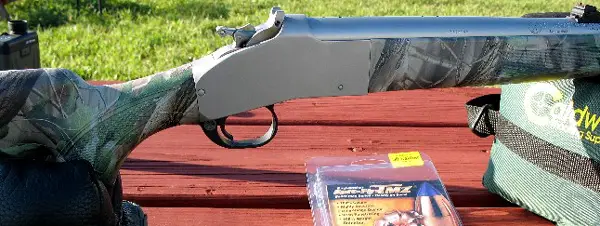|
The Knight KRB7 "Rolling Block" Rifle  Back
at the SHOT show, I was so impressed with the imminent Knight KP1 that I
glossed over Knight’s new .50 caliber KRB7 “Rolling Block” muzzleloader. Over the years,
I’ve tried my best to give praise where indicated (Knight Disc Elite) and
express disappointment when deserved (Knight Revolution). This year has seen
the introduction of the world’s clumsiest muzzleloader, Thompson’s magnificent
failure to “Triumph.” When my Knight Rolling Block arrived, I had no particular
preconceived notions about it good or bad. After spending some time with it,
now I do. The
supplied KRB7 is the stainless steel, camo composite stocked model, generally
my favored Knight format. Knight does a very good job with their composite
stocks compared to the hollow Tupperware attempts that continue to plague the
industry. The Knight’s trigger breaks at a clean 4-1/2 pounds, quite suitable
for a hunting trigger and better than many muzzleloaders out there. The rifle,
including ramrod weighs in at 7-1/2 pounds on the nose. It is a practical
weight for a .50 caliber muzzleloader, nicely balanced and it feels very good
between the hands. Calling
this rifle a “rolling block” is a bit of a stretch; it bears no semblance at
all to a classic Remington Number. It is better described as a “rolling primer
block” rifle rather than a rolling breech block. The KRB7 does away with the
Knight red plastic jackets, a consumable that I found to be a convenience in
Knight bolt actions, but a complication of no tangible value in the
Revolution/Vision series, neither of which did much for me.  Someone
must have decided that “break actions” are suddenly good for muzzleloaders,
though the break-open action is a hoary old design used in no rifles that
define accuracy today. Some are good rifles in spite of this, but the glorified
“Topper” shotgun of times past really should remain there. I’m glad this
rifle’s action does not break. I’m
also glad that Knight has not stooped to using the barrel length robbing “QLA”
or false muzzle that can also destroy accuracy if eccentric to the bore. As is
to be expected with Green Mountain barrels, they are far better quality than
most in terms of consistency, metallurgy and bore tolerances. Green Mountain
uses certified barrel materials, tests from lot to lot and Knight Rifles has
always done a very good job shooting their rifles before they hit the market.
Compared to import companies who have no clue exactly where, how, or perhaps
even why their rifles are made, this is refreshing. The
KRB7 has redundant safeties; a cross-bolt safety that serves no purpose and a
hammerblock that is integral with the hammer itself. A muzzleloader, naturally,
is never capped or primed until you intend to use it; is never transported or
out of your direct control when capped or primed. What the crossbolt is
supposed to do is a mystery to me. It
is necessary to pull the hammer back to prime the rifle. As you do, the hammer
block automatically flips up. Open the “rolling” gate and in goes a primer. The
gate has a built in 209 holder/extractor. Close the gate, close the hammer on
its integral block and you are good to go. When you recock the gun, the hammer
block stays up (or in ‘safe’ position). From above, you can push the hammer block
flush with no noise, effectively taking the rifle off safe. It is
unconventional, takes a little bit of getting used to, but quickly becomes
intuitive. At
the range, I decided to use some of the Knight 290 grain “New! EZ Load!” Barnes
PBT saboted bullets that come with a proprietary blue Knight (by MMP) sabot. Well,
they load easily all right, maybe too easily. I was able to load them with one
finger on the ramrod over a pair of Triple Seven pellets. Nevertheless, they
shot more than well enough to whack a whitetail. My initial group, using the
iron sights, was 2-1/4 inches. Changing over to the tighter fitting Barnes TMZ
290 yellow saboted bullets and spit-patching between shots, the groups
tightened to about 1-3/4 inches, about as well as I’ll do with iron sights.
There is little question that this rifle is a shooter. I’ve always been able to
get better accuracy out of weighed charges of Triple Se7en than the comparatively
inconsistent pellets and I always shoot better with a scope than with iron
sights. Nevertheless, this rifle is more than capable of putting venison in the
freezer right out of the box. Cleaning
the KRB7 could hardly be more convenient. One button and the entire action
comes out. The breechplug is then removed through the rolling gate. It is easy
and effortless. The
entire rifle has excellent build quality. It all fits together well, is easy to
operate and has remarkably good balance and handling qualities. Felt recoil,
thanks to the well-fitted recoil pad and the substantial stock, was quite
moderate with a 290 grain Barnes TMZ bullet and two Triple Seven Magnum pellets. Best of all is the price of this new Knight KRB7. Box store street prices run from $299 for the blued/black version to $399 for the stainless/camo model, making this rifle not only the best brand new model of muzzleloader I’ve tested this year, but very likely the best bargain in inline muzzleloading today. Knight is going to make a lot of hunters happy with their new KRB7, to be sure. It is a winner in my book. |